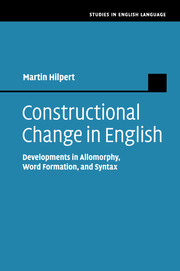Book contents
5 - Constructional change in syntax
Published online by Cambridge University Press: 05 May 2013
Summary
The previous chapters have investigated constructional change at the levels of allomorphy and word formation; the present chapter turns to a higher level of grammatical organization and focuses on syntax. Whereas Croft (2007: 504) still remarks that “relatively few studies have taken a Construction Grammar approach to syntactic change,” recent years have seen an upsurge in constructional studies addressing the diachrony of syntactic patterns (de Vogelaer 2008, Fried 2008, Hilpert and Koops 2008, Traugott 2008, Trousdale 2008a, Noël and van der Auwera 2009, Koops and Hilpert 2010, Patten 2010, amongst many others). The enterprise of diachronic Construction Grammar is thus in full swing, especially with regard to the analysis of syntactic or morphosyntactic phenomena, and there are even a number of meta-theoretical reflections on the constructional approach to the diachrony of syntax (Noël 2007, Trousdale 2010, Fried in press).
In the studies mentioned above, the constructional approach is typically wedded to the perspective of grammaticalization theory (Hopper and Traugott 2003). The introduction of this book already made the point that the subject matter of grammaticalization studies and diachronic constructional approaches is nearly coextensive. In both strands of research the focus is on grammatical changes that affect individual form-meaning pairs, typically changes that represent standard grammaticalization processes such as uni-verbation, semantic bleaching, host-class expansion, reanalysis, and the like. In keeping with the approach that was taken in earlier chapters, the purpose of the present chapter is to illustrate and analyze constructional changes that are not readily subsumed under the heading of grammaticalization, either because they involve processes that are not part of the standard inventory of grammaticalization, or because they combine several standard types of change in ways that are not predicted, or easily accommodated, by grammaticalization theory.
- Type
- Chapter
- Information
- Constructional Change in EnglishDevelopments in Allomorphy, Word Formation, and Syntax, pp. 155 - 203Publisher: Cambridge University PressPrint publication year: 2013

